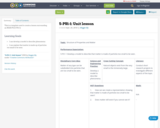
This is a template used to create a lesson surrounding an NGSS PE (5-PS1-1)
- Subject:
- Physical Science
- Material Type:
- Lesson
- Date Added:
- 06/20/2018

This is a template used to create a lesson surrounding an NGSS PE (5-PS1-1)
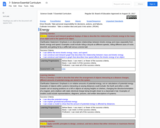
7th Grade Regular Science Scope & Sequence
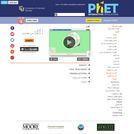
Investigate how torque causes an object to rotate. Discover the relationships between angular acceleration, moment of inertia, angular momentum and torque.

In this hands-on activity, students learn about the different realms of the Universe and explore their sizes and relative scales. They will be guided through a process that uncovers the immense sizes of the Sun, Solar System, Solar Neighborhood, Milky Way, Local Group, Supercluster, and the observable Universe. The full version of this activity involves students doing simple math computations, however it can also be done without the math. There are some inexpensive materials involved, as well as a powerpoint presentation. It is intended for grades 8-12, but can be adapted down for lower grade levels.
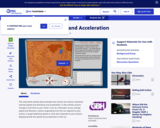
Take control of a virtual car and learn how vectors are used to represent velocity and acceleration in this interactive activity developed for Teachers' Domain. Grades 6-12.
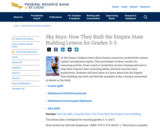
In this lesson, students learn about human resources, productivity, human capital, and physical capital. They participate in three rounds of a reasoning activity. From round to round they receive training and tools to help them improve their reasoning ability and thus increase their productivity. Students will then listen to a story about how the Empire State Building was built and identify examples of key concepts mentioned or shown in the book.
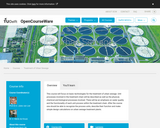
This course will focus on basic technologies for the treatment of urban sewage. Unit processes involved in the treatment chain will be described as well as the physical, chemical and biological processes involved. There will be an emphasis on water quality and the functionality of each unit process within the treatment chain. After the course one should be able to recognize the process units, describe their function and make simple design calculations on urban sewage treatment plants.
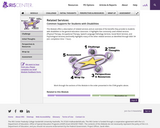
This Module offers a description of related services and an overview of the benefits they provide to students with disabilities in the general education classroom. It highlights five commonly used related services (Physical Therapy, Occupational Therapy, Speech-Language Pathology Services, Social Work Services, and Psychological Services) and briefly highlights many of the other related services as identified through IDEA '04 (est. completion time: 1 hour).

With the emerging genetic testing companies such as “23 and Me” and “Ancestry”, it is becoming more popular and accessible for families to test their own genes rather than from a primary care provider. The purpose of this activity is to analyze multiple angles of genetic testing. Students will look at multiple areas of health including mental, emotional, and physical health and how it can impact their personal health and the health of loved ones.

This course explores the physical, ecological, technological, political, economic, and cultural implications of big plans and mega-urban landscapes in a global context. It uses local and international case studies to understand the process of making major changes to urban landscape and city fabric, and to regional landscape systems. It includes lectures by leading practitioners. The assignments consider planning and design strategies across multiple scales and time frames.
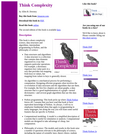
This book is about complexity science, data structures and algorithms, intermediate programming in Python, and the philosophy of science. This book focuses on discrete models, which include graphs, cellular automata, and agent-based models. They are often characterized by structure, rules and transitions rather than by equations. They tend to be more abstract than continuous models; in some cases there is no direct correspondence between the model and a physical system.

In the minerals and products activity, students match physical products with actual mineral samples, using observable properties as well as the minerals' chemical formulas and some products' ingredient lists.
(Note: this resource was added to OER Commons as part of a batch upload of over 2,200 records. If you notice an issue with the quality of the metadata, please let us know by using the 'report' button and we will flag it for consideration.)
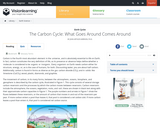
This module provides an overview of the biogeochemical carbon cycle. Major sources and sinks of carbon are discussed as well as the impact of human activities on global carbon levels.
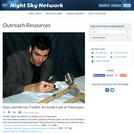
This manual provides simple demonstrations to show how lenses and mirrors are used to create telescopes. It was created for use by the Night Sky Network of astronomy clubs.
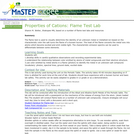
In this lab students will make qualitative observations of flame color, a property of metals, to identify unknown metals in salt compounds.
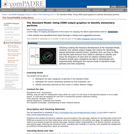
After using the historical development of the Standard Model to develop introductory understanding, students link to OPAL and DELPHI data archives from CERN to identify and study the tracks from elementary particles.
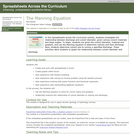
Spreadsheets Across the Curriculum Module. Students build spreadsheets to estimate discharge for a culvert using the Manning equation, and to estimate culvert size, given a specified discharge.
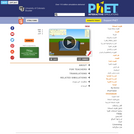
Why do objects like wood float in water? Does it depend on size? Create a custom object to explore the effects of mass and volume on density. Can you discover the relationship? Use the scale to measure the mass of an object, then hold the object under water to measure its volume. Can you identify all the mystery objects?
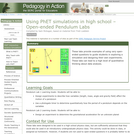
These labs provide examples of using very open-ended questions to guide students in exploring a simulation and designing their own experiments. These labs can lead to a high level of quantitative thinking about data analysis.
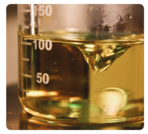
Patterns Chemistry is an instructional resource for a year-long high school introductory chemistry course. It meets many of the physical science standards from the Next Generation Science Standards, as well as some earth science standards.
The Patterns High School Science Sequence (https://hsscience4all.org/) is a three year course pathway and curriculum aligned to the Next Generation Science Standards (NGSS).
Each course utilizes:
- Common instructional strategies
- Real world phenomena
- Design challenges to engage students and support their learning.
For more information, contact us at info@pdxstem.org.
The curriculum is a combination of teacher-generated and curated open-content materials. The Teacher-generated materials are shared freely under a Attribution-NonCommercial-Sharealike Creative Commons License.